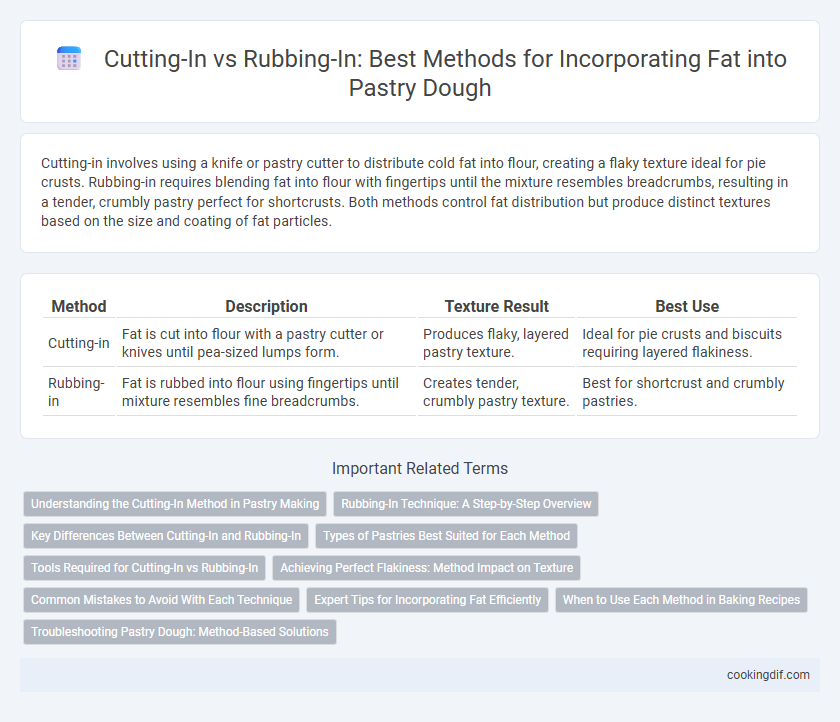Cutting-in involves using a knife or pastry cutter to distribute cold fat into flour, creating a flaky texture ideal for pie crusts. Rubbing-in requires blending fat into flour with fingertips until the mixture resembles breadcrumbs, resulting in a tender, crumbly pastry perfect for shortcrusts. Both methods control fat distribution but produce distinct textures based on the size and coating of fat particles.
Table of Comparison
| Method | Description | Texture Result | Best Use |
|---|---|---|---|
| Cutting-in | Fat is cut into flour with a pastry cutter or knives until pea-sized lumps form. | Produces flaky, layered pastry texture. | Ideal for pie crusts and biscuits requiring layered flakiness. |
| Rubbing-in | Fat is rubbed into flour using fingertips until mixture resembles fine breadcrumbs. | Creates tender, crumbly pastry texture. | Best for shortcrust and crumbly pastries. |
Understanding the Cutting-In Method in Pastry Making
The cutting-in method in pastry making involves incorporating cold fat into flour by using a pastry cutter, knives, or fingers to create pea-sized pieces of fat coated with flour, which ensures a tender and flaky texture. Maintaining cold fat is crucial as it prevents the fat from melting prematurely, allowing steam to form during baking and produce layers within the pastry. This technique differs from rubbing-in, which blends fat fully into flour for a crumbly texture, making cutting-in ideal for pastries like pie crusts and biscuits requiring distinct flakiness.
Rubbing-In Technique: A Step-by-Step Overview
Rubbing-in technique involves combining fat, such as butter or shortening, with flour by using fingertips to gently break down the fat into small, pea-sized pieces while coating the flour with fat evenly. This method creates a crumbly texture crucial for tender pastries like shortcrust and scones by preventing gluten overdevelopment. Maintaining cold butter and minimal handling enhances flakiness and ensures a delicate, melt-in-the-mouth pastry crust.
Key Differences Between Cutting-In and Rubbing-In
Cutting-in incorporates fat by using a pastry cutter or knives to create small, distinct flakes throughout the dough, resulting in a flaky texture ideal for pie crusts. Rubbing-in involves using fingertips to blend fat into flour until the mixture resembles coarse breadcrumbs, promoting a tender and crumbly consistency commonly used in scones and biscuits. The key difference lies in texture: cutting-in preserves fat chunks for flakiness, while rubbing-in evenly distributes fat for softness.
Types of Pastries Best Suited for Each Method
Cutting-in is ideal for flaky pastries like pie crusts and biscuits, where solid, cold fats are evenly distributed to create layers. Rubbing-in suits tender pastries such as shortcrust and scones, where fat is softened and blended to form a crumbly texture. Selecting the right method enhances the desired structural quality, with cutting-in promoting flakiness and rubbing-in ensuring tenderness.
Tools Required for Cutting-In vs Rubbing-In
Cutting-in requires specialized tools like pastry blenders or knives to evenly distribute cold fat into flour, creating a flaky texture essential for pie crusts and biscuits. Rubbing-in, on the other hand, relies on simple tools such as fingertips or a fork to manually blend fat into flour, offering more control for softer pastries and crumbly textures. Both techniques demand different approaches to the physical manipulation of dough, significantly influencing the final product's consistency and crumb.
Achieving Perfect Flakiness: Method Impact on Texture
Cutting-in involves using a pastry cutter or knives to evenly distribute cold fat into flour, creating distinct fat layers that produce a flaky, tender pastry texture. Rubbing-in requires hand-mixing fat and flour until the mixture resembles coarse crumbs, resulting in a denser, crumbly texture ideal for shortcrust pastries. The choice between cutting-in and rubbing-in directly impacts the pastry's flakiness and tenderness, essential for achieving the desired mouthfeel and structure.
Common Mistakes to Avoid With Each Technique
Cutting-in butter often leads to uneven distribution if the fat is too warm, resulting in a dense pastry rather than a flaky texture. Rubbing-in can cause overworking the dough, which activates gluten and makes the pastry tough instead of light and crumbly. Maintaining cold ingredients and working quickly prevents these common mistakes and ensures an ideal pastry crumb.
Expert Tips for Incorporating Fat Efficiently
Cutting-in and rubbing-in are essential techniques for incorporating fat into flour, affecting pastry texture significantly. Cutting-in involves using a pastry cutter to create pea-sized fat pieces, resulting in a flakier crust, while rubbing-in requires gently working fat into flour with fingertips for a tender, crumbly finish. Experts recommend chilling fat before cutting-in to maintain distinct layers and using the rubbing-in method for shortcrust pastries to prevent overworking the dough.
When to Use Each Method in Baking Recipes
Cutting-in is ideal for recipes requiring flaky textures, such as pie crusts and biscuits, where solid fat is distributed in small pieces throughout the dough to create layers. Rubbing-in suits tender pastries like scones and shortcrusts, as it evenly combines fat with flour to form a crumbly, fine mixture essential for a soft crumb. Understanding when to use cutting-in versus rubbing-in ensures optimal texture and structure in baked goods.
Troubleshooting Pastry Dough: Method-Based Solutions
Cutting-in involves using a pastry cutter or knives to break cold fat into small pieces within flour, producing a flaky texture, while rubbing-in requires using fingertips to blend fat thoroughly, resulting in a tender crumb. Troubleshooting pastry dough often depends on method precision: cutting-in too finely can lead to a dense crust, whereas over-rubbing fat can cause greasy, tough dough. Ensuring the fat remains cold and evenly distributed without overworking the dough is essential for optimal pastry structure and texture.
Cutting-in vs Rubbing-in for incorporating fat Infographic

 cookingdif.com
cookingdif.com